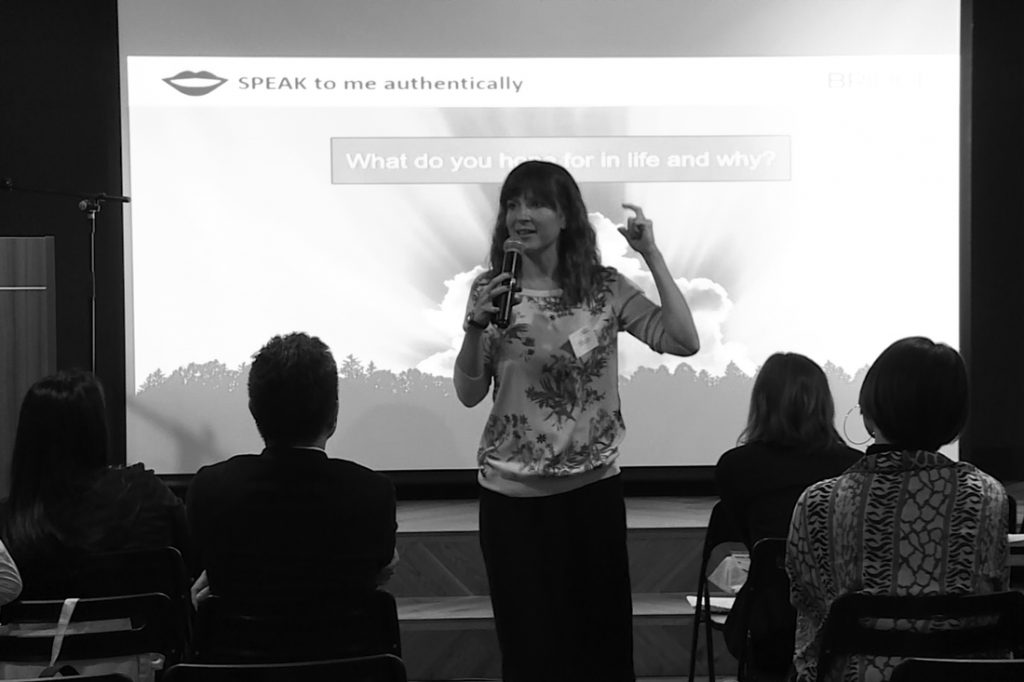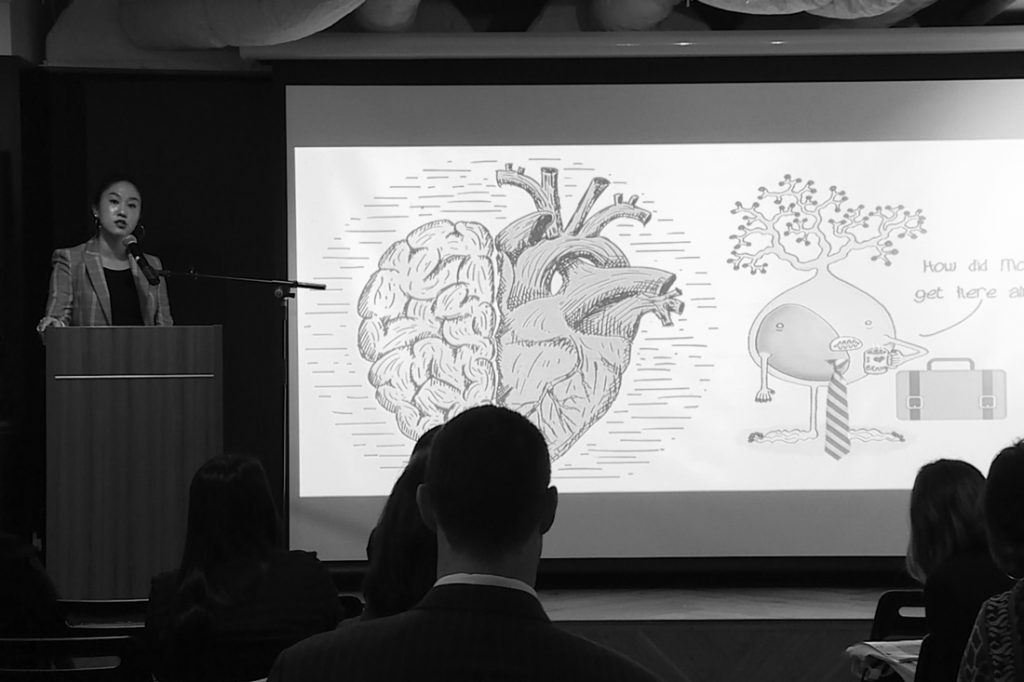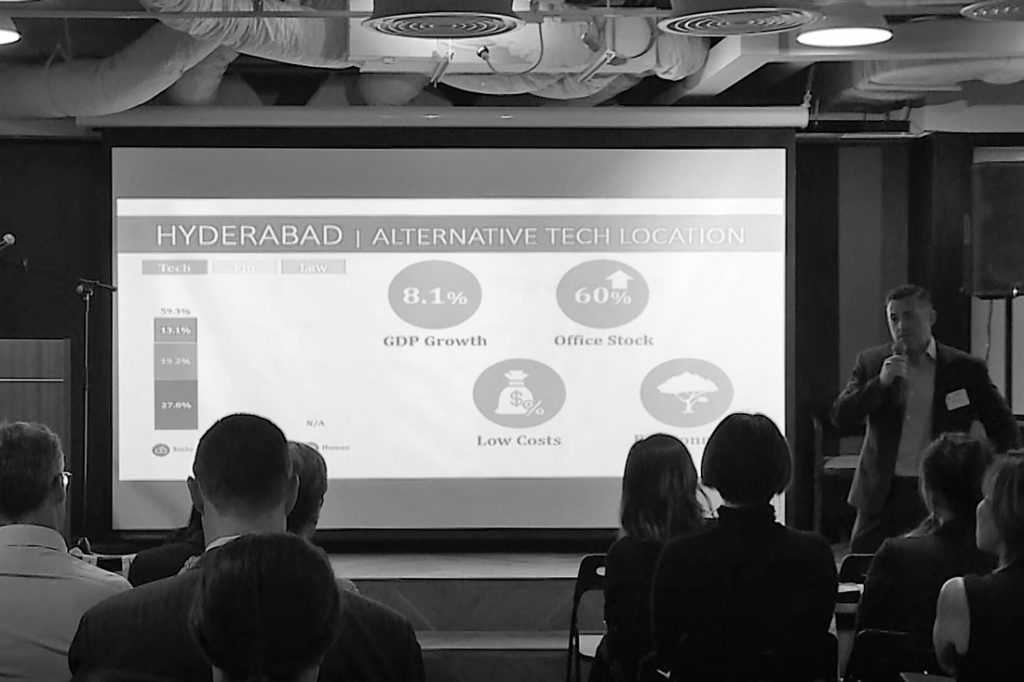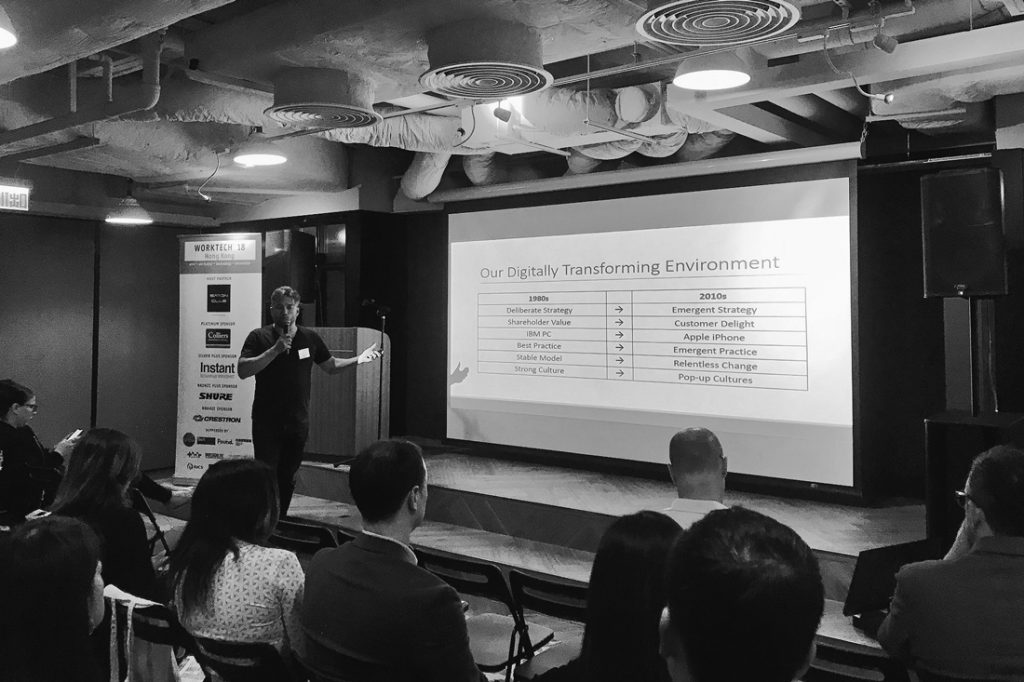This one-day conference looked at bespoke workspace solutions, where co-working is headed, how workplaces can support performance, and much more.

The latest stop on WORKTECH’s world tour was Hong Kong. On 5 December 2018, senior professionals from tech startups, major banks, real estate, design and architecture firms and more gathered at Eaton Club in Hong Kong to discuss workplace transformation, and the technologies, practices and behaviours that are shaping the work environments of the future.
Here, we look at some of the major themes that emerged throughout the day, and some of the insights the speakers and panelists offered.

Organisations are moving toward flexible office space, and coworking is growing rapidly – particularly in the APAC region, said speakers. Indeed, APAC is the fastest-growing flex workspace market in the world, with 4,500 centres across 2,100 operators and flex space supply increasing by 50 per cent year on year.
It’s important, however, to understand the difference between flex workspace and coworking: coworking is about sitting in a shared office across from someone who probably works in a completely different industry from you. Flex workspaces, meanwhile, are those that are agile and flexible.
WeWork has made coworking a real buzzword over the last five years or so, but now, said the speakers, there is some backlash as organisations realise a fully coworking model does not suit their corporate culture.
Standard Chartered panelist Shelly Boland, the bank’s Head of Property, Greater China and North Asia, talked about how they have partnered with WeWork for Powered by We, pointing out that this flexible model – which involves Standard Chartered staff working in offices that are ostensibly WeWork spaces – is something they apply to aspects of their business only, for more bespoke projects and transformational work. “There are things you lose on the productivity side if you move the whole organisation [into flex space],” she said.
The key, said Happy Le from Brookfield Global Integrated Solutions, lies in finding a balance: how agile can your organisation go? Can you be fully agile or only partly agile?

In order to really understand how agile you can go, various companies advocate first surveying staff to get a measure of how they feel about their current space and what works and what doesn’t. This is something Willis Towers Watson did before embarking on massive transformation to highly flexible workspaces across 40 of their global offices. Inabelle Fang, Global Real Estate Manager from the company, explained that they used four different methods to gauge what was needed.
Since 2013, they have already seen US$85.7 million in annualised financial benefits from making the change – in part due to better communications and productivity, and also due to the fact that they no longer need so much office space.
Fang pointed out that this is an ongoing consideration; something Willis Tower Watson monitors by using Workplace Fabric’s Freespace analytics to determine how much of the offices are occupied at any one time, and which areas are not being used. This has already resulted in the realisation that one whole floor of their Chicago office was barely being used.
According to Fang, the cost of using Freespace is minimal: just 0.7 per cent of total occupancy costs.
Google’s Workplace Design Journey was one of the first topics under discussion at WORKTECH18, with Valentine discussing the new floor they recently opened up in the Hong Kong office, with the help of M Moser Associates.
Rather than looking at what the company had done with the other floors of the Hong Kong office, Google and M Moser decided to start from scratch. They took inspiration from Italian urban planning and the idea of piazzas and courtyards.
The new office floor’s open, community spaces – where there is surprisingly little tech, in order to encourage face-to-face interaction – were modelled on the piazza idea, while courtyard concepts informed the more intimate meeting spaces.
The aim was to encourage chance encounters and cross-team connection; something they did via hydration points.
It was a real-life reflection of Rob Van Alphen from School of Disruption’s argument that twentieth-century organisations need to behave differently in the twenty-first century – and of behavioural scientist Dr Richard Claydon’s point that we need to get rid of this idea of “best practice”. In his talk on organisational misbehaviour, he said that “Best practice says that it’s something that cannot be improved, because it implies that it’s already best,” whereas the reality is that best practices are preventing companies from being open to emergent or innovative practices. Organisational drag is the costly result of best practices and other legacy systems, which are impacting the way we work today. According to Claydon’s research, the cost to the US in terms of lost productivity is US$3 trillion a year, and across the 32 OECD countries, he estimates that cost may be as high as US$9 trillion per year.

Whatever your views of AI, it’s a key part of the tech megatrend that Alphen talked about, and some organisations are already using it to help create efficient, high-performance workplaces. Take Google, for example: Valentine talked about Meeting Nanny, their AI-driven meeting-room monitor, which monitors how and when rooms and areas are used, booting your booking out of a meeting room if you’re not there within 15 minutes, and also switching lights off when rooms aren’t in use.
In Willis Towers Watson’s new offices, an ‘intelligent’ system driven by sensors keeps desk usage efficient: if you’re away from the desk you’re occupying for more than 2 hours and 15 minutes, the system will boot you off that desk.
How do you use workspace to encourage the ‘right’ behaviours? Don’t go for open-plan workspace, says Claydon. He says open-plan offices have increased emailing by 67 percent, which hurts productivity (especially when you consider that 62 percent of our emails are noise that adds no value).
He also advocates a minimum of 78 square feet of workspace per person; anything below this and you will see a drop in productivity when it comes to complex work. High performers generally have at least this much space, said Claydon – incidentally, Willis Towers Watson is targeting 125 square feet per person (it’s currently at 144 square feet per person, and 156 square feet per desk).
Also important is getting the balance right when it comes to noise. “If it’s too noisy you’re distracted,” said Claydon. “If open-plan offices are incredibly quiet, any little noise can be hugely distracting. Distraction causes poor performance.”
Making space for collaboration is obviously important – according to Claydon, this is the most valuable form of work, particularly when done in analogue form away from tech, because it is here that ideas get exchanged. Deep work is also important, but this needs to be free from the distractions of email, social media, noise disturbances, et cetera.

“The main thing you can do to futureproof your business is to become more human,” Alix Farquhar from Bridge Partnership quoted her friend, a futurist for the World Economic Forum, and making workplaces more human was the subject of her talk at WORKTECH18 in Hong Kong.
Having purpose is a big part of this. “Knowing why you get up in the morning is so fundamental for people,” said Farquhar, explaining that this will drive them to achieve more and perform better. “The teams that are most successful, and that are successful over a period of time, are those that are constantly reestablishing their purpose.”
Read about digital transformation and company culture – key themes discussed at WORKTECH Singapore 2018 here.
A searchable and comprehensive guide for specifying leading products and their suppliers
Keep up to date with the latest and greatest from our industry BFF's!

Savage Design’s approach to understanding the relationship between design concepts and user experience, particularly with metalwork, transcends traditional boundaries, blending timeless craftsmanship with digital innovation to create enduring elegance in objects, furnishings, and door furniture.

Channelling the enchanting ambience of the Caffè Greco in Rome, Budapest’s historic Gerbeaud, and Grossi Florentino in Melbourne, Ross Didier’s new collection evokes the designer’s affinity for café experience, while delivering refined seating for contemporary hospitality interiors.

It’s time to take a peek inside NEXTDC M2 designed by HDR, an altogether different approach for workplace interiors.

In this comment piece by Lin (Leo) Meng, computational design lead at HDR, we hear about the interface of data and design.

Coworking spaces continues to grow in line with demand in Australia. The hospitality-led coworking space, The Great Room, has recently launched its first Australian location in the heart of Sydney’s CBD.

Recently, we took you through some of the key takeaways from Worktech Melbourne. As the event rolled into Sydney, we decided to delve a little deeper into a couple of important talks featuring leaders from Gallup, Veldhoen + Company and UTS.
The internet never sleeps! Here's the stuff you might have missed

In Malaysia Spacemen has created a world of perfumed wonder with their latest project, Trove, where treasures abound.

We spoke with George Fleck, Vice President and Global Brand Leader of W Hotels, about the intermingling of hotel and hospitality design trends.